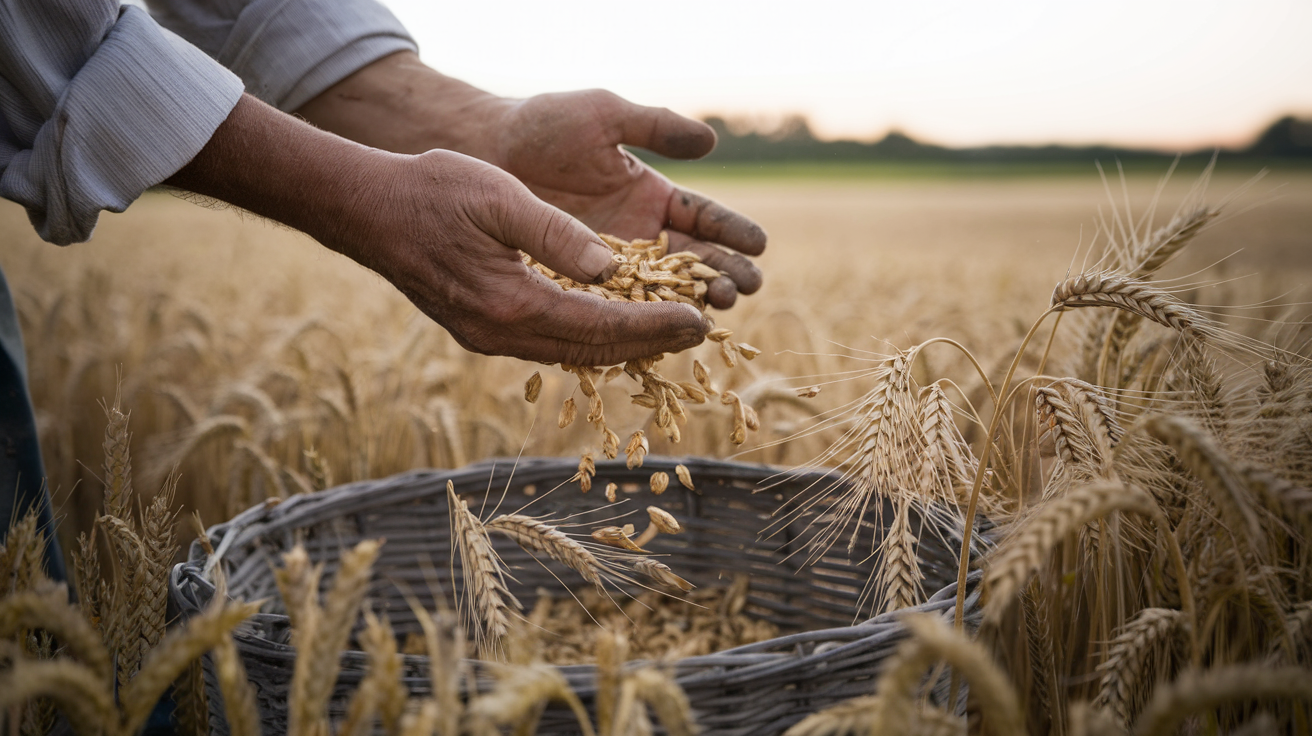Welcome to Rhys Garden, where we explore the art and science of cultivating nature’s bounty. Today, we’re delving into the timeless practice of harvesting wheat by hand. This ancient technique, deeply rooted in agricultural history, offers a unique connection to the land and a profound appreciation for the food we eat.
The Timeless Art of Hand Harvesting Wheat
Hand harvesting wheat is a labor-intensive yet rewarding process that has been practiced for thousands of years. This traditional method allows farmers to select the best grains, minimize waste, and maintain a close relationship with their crops. At Rhys Garden, we believe in preserving these time-honored techniques while embracing modern sustainable farming practices.
Before we dive into the harvesting process, let’s familiarize ourselves with the essential tools:
- Sickle or scythe: The primary cutting tool
- Cradle: Attached to the scythe to catch and lay the wheat neatly
- Rake: Used to gather cut wheat
- Sheaf ties: For bundling wheat stalks
- Threshing flail: To separate grain from stalks
- Winnowing basket: For cleaning the grain
Preparing for the Harvest
Timing is Everything
Knowing when to harvest is crucial for achieving the best quality wheat. As gardening enthusiasts, we understand the importance of timing in all aspects of plant care, from sowing seeds to pruning shrubs. The same principle applies to wheat harvesting.
Signs of Readiness:
- The wheat has turned from green to golden brown
- Grains are firm when pressed between your teeth
- Moisture content is around 13-14%
Field Preparation
Before harvesting, ensure your wheat field is in optimal condition:
- Remove any weeds that might interfere with the harvest
- Check for any signs of disease or pest infestation
- Clear the area of debris and obstacles
The Step-by-Step Process of Hand Harvesting Wheat

Cutting the Wheat
Using a sharp sickle or scythe, cut the wheat stalks close to the ground. If using a scythe with a cradle, the cut wheat will fall neatly in a row, making it easier to gather.
Pro Tip: Maintain a steady rhythm and keep your tools sharp for efficient cutting.
Gathering and Bundling
After cutting, use a rake to gather the wheat into manageable piles. Then, create bundles called sheaves:
- Gather a handful of wheat stalks
- Align the heads
- Use some of the stalks or twine to tie the bundle securely
Fun Fact: In traditional farming communities, sheaf-making was often a social activity, bringing people together during harvest time.
Shocking the Wheat
To allow the wheat to dry further, create shocks by standing several sheaves together:
- Stand 6-8 sheaves in a circular pattern
- Lean them against each other for support
- Place two sheaves on top as a “cap” to protect from rain
This process, reminiscent of creating tepees in a vegetable garden for climbing plants, allows air to circulate and prevents mold growth.
Threshing
Once the wheat is dry, it’s time to separate the grain from the stalks:
- Spread a tarp on the ground
- Beat the wheat heads with a flail or by trampling
- The grains will fall onto the tarp
Winnowing
The final step is to clean the grain:
- Pour the threshed wheat from one container to another on a breezy day
- The wind will blow away the chaff, leaving clean grain behind
This process is similar to how we might clean harvested seeds from our garden plants.
The Benefits of Hand Harvesting Wheat
Quality Control
Hand harvesting allows for careful selection of the best wheat, ensuring high-quality grain for consumption or replanting.
Minimal Waste
Unlike mechanical harvesting, hand harvesting can utilize every part of the wheat plant, from grain to straw.
Environmental Impact
Hand harvesting requires no fossil fuels and has a lower impact on soil compaction compared to heavy machinery.
Preservation of Heritage Varieties
Many ancient wheat varieties are better suited to hand harvesting, helping to maintain genetic diversity in our food system.
Challenges and Considerations
While hand harvesting wheat offers many benefits, it’s important to acknowledge its challenges:
- Labor-intensive: Requires significant time and physical effort
- Weather dependent: Harvest must be timed around suitable weather conditions
- Skill requirement: Proper technique is necessary for efficiency and quality
Integrating Hand Harvesting into Modern Agriculture
Small-Scale and Organic Farming
Hand harvesting is particularly well-suited to small-scale and organic farming operations. It allows for careful crop management and aligns with principles of sustainable agriculture.
Educational Opportunities
Many farms and gardens, like Rhys Garden, offer workshops on traditional harvesting techniques. These hands-on experiences provide valuable insights into food production and agricultural history.
Artisanal and Specialty Products
Hand-harvested wheat is often sought after for artisanal bread-making and specialty grain products, commanding premium prices in niche markets.
The Future of Hand Harvesting Wheat
As interest in sustainable and traditional farming practices grows, hand harvesting wheat may see a resurgence. Innovations in small-scale farming equipment and a renewed appreciation for artisanal foods are contributing to this trend.
While preserving traditional methods, some farmers are incorporating modern tools to enhance efficiency:
- Ergonomic hand tools for reduced strain
- Small-scale threshing machines for quicker processing
- Solar-powered grain cleaning equipment
Frequently Asked Questions
Q1: How long does it take to hand harvest an acre of wheat?
A: The time required can vary greatly depending on experience and conditions, but on average, it might take 15-20 hours to harvest an acre by hand.
Q2: Is hand-harvested wheat more nutritious?
A: While the harvesting method doesn’t directly affect nutrition, hand-harvested wheat is often from heritage varieties or grown using organic methods, which may offer nutritional benefits.
Q3: Can I hand harvest wheat from my home garden?
A: Absolutely! Even a small plot can yield enough wheat for personal use. It’s a great way to connect with your food and learn about grain production.
Q4: What can I do with the wheat straw after harvesting?
A: Wheat straw has many uses, including mulch for your garden, bedding for animals, or material for craft projects.
Q5: How do I store hand-harvested wheat?
A: Properly dried wheat can be stored in airtight containers in a cool, dry place for several months to a year.
Conclusion
Hand harvesting wheat is more than just a method of gathering grain; it’s a connection to our agricultural heritage and a step towards sustainable food production. At Rhys Garden, we believe in the value of understanding and preserving these traditional practices. Whether you’re a home gardener curious about growing your own wheat or a farmer looking to diversify your techniques, hand harvesting offers a unique and rewarding experience.
By embracing methods like hand harvesting, we cultivate not only wheat but also a deeper appreciation for the food we eat and the land that provides it. As we look to the future of agriculture, let’s not forget the wisdom and value inherent in these time-honored practices.
Remember, every grain tells a story – and when you harvest by hand, you become part of that story. Happy harvesting!

Related Posts
Are Wild Flowers Perennial? Unveiling Nature’s Blooming Secrets
Growing Johnny Jump Up Seeds: A Gardener’s Guide to Viola Tricolor
The Art of Transplanting Japanese Maple